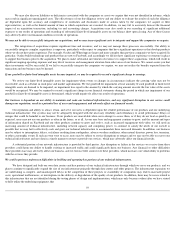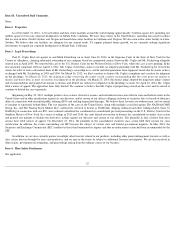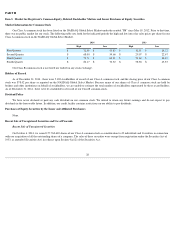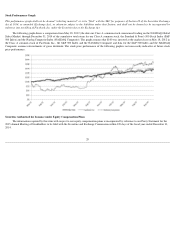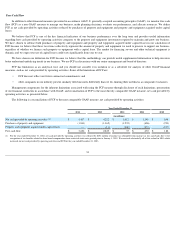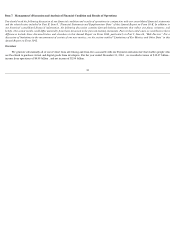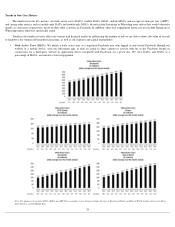Facebook 2014 Annual Report Download - page 27
Download and view the complete annual report
Please find page 27 of the 2014 Facebook annual report below. You can navigate through the pages in the report by either clicking on the pages listed below, or by using the keyword search tool below to find specific information within the annual report.
We may have exposure to greater than anticipated tax liabilities.
Our income tax obligations are based in part on our corporate operating structure and intercompany arrangements, including the manner in which
we develop, value, and use our intellectual property and the valuations of our intercompany transactions. The tax laws applicable to our business,
including the laws of the United States and other jurisdictions, are subject to interpretation and certain jurisdictions are aggressively interpreting their
laws in new ways in an effort to raise additional tax revenue from companies such as Facebook. The taxing authorities of the jurisdictions in which we
operate may challenge our methodologies for valuing developed technology or intercompany arrangements, which could increase our worldwide
effective tax rate and harm our financial position and results of operations. We are subject to regular review and audit by U.S. federal and state and
foreign tax authorities. Tax authorities may disagree with certain positions we have taken and any adverse outcome of such a review or audit could have
a negative effect on our financial position and results of operations. In addition, the determination of our worldwide provision for income taxes and other
tax liabilities requires significant judgment by management, and there are many transactions where the ultimate tax determination is uncertain. Although
we believe that our estimates are reasonable, the ultimate tax outcome may differ from the amounts recorded in our financial statements and may
materially affect our financial results in the period or periods for which such determination is made.
In addition, our future income taxes could be
adversely affected by earnings being lower than anticipated in jurisdictions that have lower statutory tax rates and higher than anticipated in jurisdictions
that have higher statutory tax rates, by changes in the valuation of our deferred tax assets and liabilities, or by changes in tax laws, regulations, or
accounting principles. For example, we have previously incurred losses in certain international subsidiaries that resulted in an effective tax rate that is
significantly higher than the statutory tax rate in the United States and this could continue to happen in the future.
Changes in tax laws or tax rulings could materially affect our financial position and results of operations.
Changes in tax laws or tax rulings could materially affect our financial position and results of operations. For example, the current U.S.
administration and key members of Congress have made public statements indicating that tax reform is a priority. Certain changes to U.S. tax laws,
including limitations on the ability to defer U.S. taxation on earnings outside of the United States until those earnings are repatriated to the United
States, could affect the tax treatment of our foreign earnings. In addition, many countries in the European Union, as well as a number of other countries
and organizations such as the Organization for Economic Cooperation and Development, are actively considering changes to existing tax laws. Certain
proposals could include recommendations that would significantly increase our tax obligations in many countries where we do business. Due to the large
and expanding scale of our international business activities, any changes in the taxation of such activities may increase our worldwide effective tax rate
and harm our financial position and results of operations.
Risks Related to Ownership of Our Class A Common Stock
The trading price of our Class A common stock has been and will likely continue to be volatile.
The trading price of our Class A common stock has been, and is likely to continue to be, volatile. Since shares of our Class A common stock were
sold in our IPO in May 2012 at a price of $38.00 per share, our stock price has ranged from $17.55 to $82.17
through December 31, 2014. In addition to
the factors discussed in this Annual Report on Form 10-
K, the trading price of our Class A common stock may fluctuate significantly in response to
numerous factors, many of which are beyond our control, including:
24
•
actual or anticipated fluctuations in our revenue and other operating results;
•
the financial projections we may provide to the public, any changes in these projections or our failure to meet these projections;
•
actions of securities analysts who initiate or maintain coverage of us, changes in financial estimates by any securities analysts who follow
our company, or our failure to meet these estimates or the expectations of investors;
•
additional shares of our Class A common stock being sold into the market by us, our existing stockholders, or in connection with
acquisitions, including shares sold by our employees to cover tax liabilities in connection with RSU vesting events, or the anticipation of
such sales;
•
investor sentiment with respect to our competitors, our business partners, and our industry in general;
•
announcements by us or our competitors of significant products or features, technical innovations, acquisitions, strategic partnerships, joint
ventures, or capital commitments;
•
announcements by us or estimates by third parties of actual or anticipated changes in the size of our user base, the level of user
engagement, or the effectiveness of our ad products;
•
changes in operating performance and stock market valuations of technology companies in our industry, including our







